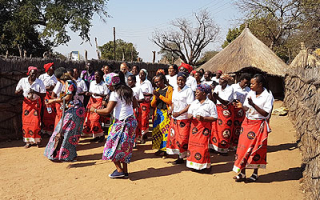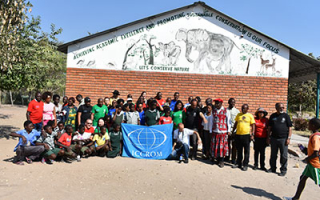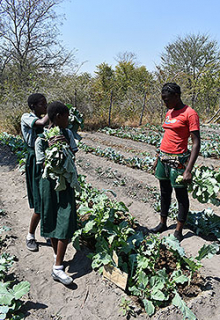In the magnificent setting of the Victoria Falls/ Mosi-oa-Tunya transboundary World Heritage Site shared by Zambia and Zimbabwe, 20 participants from 16 different African countries explored the challenge of putting people back into the centre of conservation. The People-Nature-Culture (PNC) course provides conservation practitioners with the necessary knowledge and tools to work more effectively with communities through existing management systems so to pursue the wellbeing of both heritage (natural and cultural) and society as a whole.
This course was an opportunity to create a forum for participants to share their own experiences from both the cultural and natural heritage sectors, learning from each other and others who are actively involved with communities and heritage. Over two weeks, they enjoyed a rich programme of presentations, interactive sessions on sharing experiences, site visits and practical exercises of applying various different tools.
Site visits coordinated with the extensive collaboration with the National Heritage Conservation Commission of Zambia included the Mosi-oa-Tunya / Victoria Falls World Heritage Site and the Mukuni village that allowed participants to go in depth on the intangible values and community groups linked to the site. The Mukuni pride themselves to be the ‘owners’ of the Falls, as history records their presence as early as the 9th century. They periodically perform rituals to appease their god whom they believe resides in the Falls. Their rights of access to the site, and their inclusion in the overall decision-making process of site conservation, play an important role in steering the site in the right direction.
The Mosi-oa-Tunya National Park acts as the buffer zone of the World Heritage site. A wide variety of species including antelope, zebras, giraffe, warthogs and the very rare white rhinos find their home here. The course therefore discussed in depth the challenge of managing different categories of heritage designation amongst different institutions.
Livingstone town and its museums, the railway museum and the Rhodes Livingstone Museum gave the group an understanding of the history of the town and its main cultural values. Mosi-Oa-Tunya / Victoria Falls are not only features of the natural world, but also serve as the backdrop to many cultural, social and economic initiatives that occurred at this important juncture.
Lupani Community School, Sekute Conservancy and Simalaha Community Conservancy were the numerous case studies that provided positive input into how conservation decisions can be directed to benefit the local society in many different ways. This highlighted the importance of collaboration between a network of partners as well as having an inclusive decision-making structure to share the benefits.
During the final session, participants shared their analysis of the Mosi-oa-Tunya World Heritage property. They proposed improvements for the future cycle of the Joint Integrated Management Plan of the site, providing both state parties and their respective institutions ideas for better methods and tools to adopt for future reference.
One participant reflected on the overall experience of the course, saying:
“this course opened our minds. I will go back as a different person, a different professional.”
This regional course is the first edition of ‘People, Nature, Culture.’ It builds on the successes of previous courses on ‘Promoting People-Centred Approaches to Conservation’ (2015, 2016 and 2017) and ‘Linking Nature and Culture’ (2014 and 2017). The course is part of the World Heritage Leadership Programme, delivered by IUCN and ICCROM in collaboration with ICOMOS and World Heritage Centre and other organizations, developed with the support of the Norwegian Ministry of Climate and Environment and other partners. This programme focuses on promoting links between nature-culture-people in the management of heritage sites and securing heritage a more dynamic role in wider sustainable development.
Partners:
- ICCROM
- IUCN
- Norwegian Ministry of Climate and Environment
- African World Heritage Fund
- National Heritage Conservation Commission of Zambia
Member States represented: Botswana, Côte d’Ivoire, Egypt, Ethiopia, Kenya, Lesotho, Madagascar, Malawi, Mauritius, Mozambique, Nigeria, Rwanda, South Africa, United Republic of Tanzania, Zambia, Zimbabwe.
Notes on three community initiatives visited by the PNC18 course
Lupani School
Lupani School is a project promoted by the African Wildlife Foundation (AWF) through its Classrooms in Africa project. The Sekute Chiefdom pledged the protection of the Sekute Conservancy, which spans approximately 20,000 ha. In return, AWF funded the school buildings and facilities, while the Local District Education Authority ensured the support of teachers, provision of educational curriculum and administration.
In 2010, the school started out as a modest one-classroom school which served 64 students from the neighbourhood. Today, thanks to the commitment of all the participating parties and the will of the community, the school is a centre of excellence, counting 291 pupils. The school firmly believes in the power of learning outside the classroom and upbringing the children in their local areas of conservation, teaching them the importance of protecting resources, and building long-term knowledge and awareness. The students take care of the plants and the trees around the school, and also learn how to plant and farm vegetables for their own practical sustenance. Over the years, the school has also excelled in academic performance, with the students scoring over 40% higher than the national average.
Students at the Lupani School performed powerful recitals of poems that they composed on the themes of heritage, wildlife protection and the need for education.The level of understanding and motivation for positive action shown by the students on these particular issues gave an impressive message, and serves as a powerful example of how the local community and committed individuals can make a difference for the sustainable benefit of the collective group.
The school is now facing a phase of change where it must find new resources to be able to continue on. For this reason, the community is launching new visitor lodges that will bring in the necessary financial resources.
Sekute Conservancy
The Sekute Conservancy is structured as a Trust within the Sekute chiefdom, which includes 300 villages. The Conservancy has three main aims, supported by AWF to be realized on the ground. One is to manage natural resources in a sustainable way, by promoting wildlife conservation and fishing management in the Zambezi River, a shared resource among many countries and multiple communities. Further aims include to increase the education standards in the chiefdom, as demonstrated by the Lupani School, and to promote community-led enterprises, to bring back benefits to the local community.
Simalaha Community Conservancy
The Simalaha Community Conservancy is the largest such conservancy worldwide. It is a community-driven initiative for the Kavango Zambezi Transfrontier Conservation Area, including communities in Angola, Botswana, Namibia, Zambia, and Zimbabwe. Five thousand people live within the conservation area, and all its projects start from the village action groups. The following are among few of the activities carried out in the last ten years.
- Repopulation of 73 different animal species no longer present in the area
- Fighting poaching and regulating fishing, and providing alternative measures for other economic activities such as conservation agriculture
- Providing training on conservation agriculture – 800 families have now been taught how to farm and build up the soil using an organic methodology
- Reduction of chuckle burning
- Investment in infrastructure improvement, especially for schools and teacher housing which are provided with solar panels
- Promoting the area and encouraging visitors.




